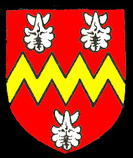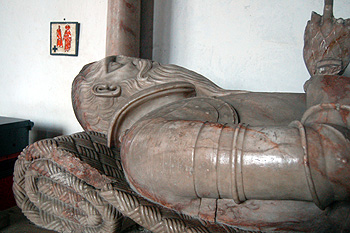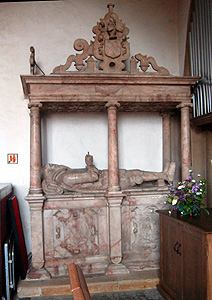The Dyve Family of Bromham

The Dyve family coat of arms
William Camden in his Britannia written between 1577 and 1610, states that Gosceline de Dyve came over to England with William the Conqueror (1066-1087). F. W. Kuhlicke, in an article in The Bedfordshire Magazine, noted that Camden's scholarship "must be treated with caution". He goes on to note that a Leodar de Dive held land in Northamptonshire in the early 13th century, where the family remained until 1553.
That was the year in which Sir Lewis Dyve purchased the Manor of Bowels. He purchased the Manor of Wakes three years later and the Manor of Brayes in 1565 and with it them the greater part of the parish of Bromham, only the second Bromham Manor evading his grasp, falling into the hands of the Boteler family of Biddenham, with whom the Dyves feuded for a number of years at the end of the 16th century.

Close up of the monument to Sir Lewis Dyve May 2012
Sir Lewis was Sheriff of Bedfordshire and Buckinghamshire under King Henry VIII (1509-1547) in 1544. His father was William Dive and his grandfather Sir John Dive, knighted in 1510 who had also been Sheriff of the two counties. Sir John's father had married Elizabeth, daughter of Thomas Wilde of Bromham which seems to be the earliest connection with Bedfordshire and with Bromham in particular.
Sir Lewis died in 1592. He was buried in Bromham church where his monument can be seen at the east end of the north aisle.

The monument to Sir Lewis Dyve May 2012
Sir Lewis' son John was Sheriff of Bedfordshire in 1593 and 1603 and was knighted in the latter year. He died in 1607. His son, born in 1599, was named after his grandfather and became nationally prominent during the first Civil War between King Charles I (1625-1649) and Parliament. He was captured by parliament in 1645 and all his estates taken from him. He escaped from the Tower of London in 1647 and fled abroad, returning with King Charles II (1660-1685) and settling in Somerset. His estates were returned and he conveyed them to his son Francis in 1664, dying that same year and being buried at Combehay.
Francis Dyve presented a new pulpit to the church and was a Gentleman of the King's Privy Chamber. He diede in the same year as his monarch and left the Bromham estates to his brother Captain Lewis Dyve, aged 53 and living at Wexford in Ireland. He died the year after his brother.
The final member of the family to own land in Bromham was another Lewis, named after his father, who was born at Wexford in 1677 and who lived at Bromham from 1700 to 1708. In the latter year he performed an ironic sale of the estate. He was the son of a great Royalist and the estate's buyer was Sir Thomas Trevor (later 1st Baron Trevor of Bromham), grandson of a great parliamentarian, John Hampden. The sale price was a colossal £21,394/2/6, many millions by todays standards.